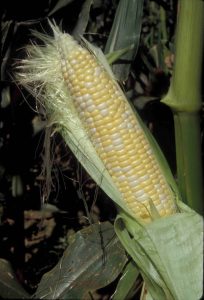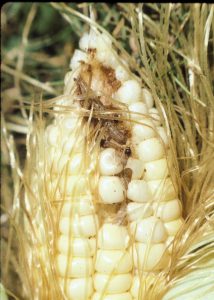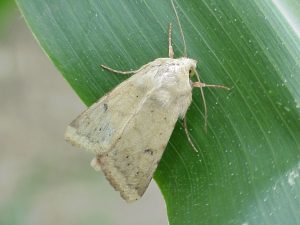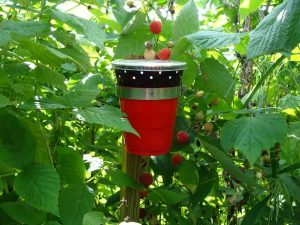Sweet Corn IPM Newsletter No. 5- July 31, 2020
Sweet Corn IPM Newsletter No. 5- July 31, 2020

Click on photos to enlarge
FALL ARMYWORM COUNTS RISING
Most Silking Corn Fields Require Protection
SITUATION
A heat wave has kept corn development at a speedy pace, especially where irrigation is available. Some fields are looking dry again, where showers have been sparse. A tropical storm headed our way next week may bring some needed rain to those fields, but may also carry more corn earworm and/or fall armyworm into the state. Fall army-worm moth counts are up again in most sites this week, but larval feeding damage to young corn remains low, so the primary threat is to silking corn.

European corn borer:
Larval feeding injury was not over the 15% control threshold for pre-tassel corn at any location scouted this week. Moth counts were also lower and exceeded the threshold for silking corn only in Sabattus and Wayne.

Corn earworm:
Moth captures were mostly lower this week, and some sites have not yet caught any moths. A six-day spray interval for silking corn was recommended in: Cape Elizabeth, Charleston, Dayton, New Gloucester, Monmouth, and one Wells site. A five-day spray interval was recommended for silking fields in Biddeford.
Fall armyworm (FAW):

Moth captures were higher and were caught at most locations. It appears many sites saw a significant influx of moths this week. Moths exceeded the three-per-week threshold for silking corn in: Biddeford, Bowdoinham, Cape Elizabeth, Lewiston, New Gloucester, Oxford, Wells, Wayne and one Dayton site. A spray to protect silking fields from fall armyworm infestation was recommended in Lewiston, Oxford, Wayne and Wells. All other sites are presently under a spray interval for corn earworm, and no additional spray for FAW was required. Larval feeding damage on younger corn did not exceed the threshold anywhere this week, but we expect to see more soon.

Western Bean Cutworm:
We’re finding higher numbers of this “new” pest at our trapping locations this week, including; Biddeford (11), Cape Elizabeth (8), Dayton (3), Lewiston (17), New Gloucester (6), Oxford (30), Poland Spring (63), Wayne (6) and Wells (10). The larvae of western bean cutworms feed on corn plants and move into the ears through the silk channels or the husks. Their feeding habits are similar to fall armyworm. There is no established threshold for moth captures in silking corn. However, sprays for corn earworm and fall armyworm should protect silking corn from western bean cutworm as well. The threshold for feeding injury on plants is 8%.

Squash vine borer
moths were caught in pheromone traps in Biddeford (3), Farmington (3), and Wells (7) this week. Only the Wells site was over the threshold of five moths per week for a spray to protect summer and winter squash, and pumpkins.
Spotted wing drosophila:

The number of flies caught in traps continue to increase in raspberry and blueberry fields this week, raising the threat level to any ripening berries. A 7-day spray interval for fields with ripe raspberries, blackberries and blueberries is recommended.
For more information visit our website:
Sincerely,
David T. Handley
Vegetable and Small Fruit Specialist
Highmoor Farm Pest Mgmt. Unit
P.O. Box 179 17 Godfrey Drive
52 U.S. Route 202 Orono, ME 04473
Monmouth, ME 04259 1.800.287.0279
207.933.2100
| Location | CEW
Moths |
ECB
Moths |
FAW
Moths |
%Feeding
Damage |
Recommendations / Comments |
|---|---|---|---|---|---|
| Biddeford | 4 | 1 | 24 | 0% | 5-day spray interval for all silking corn |
| Bowdoinham | 0 | 0 | 3 | 8% | One spray for FAW on silking corn |
| Cape Elizabeth | 3 | 0 | 10 | 0% | 6-day spray interval for all silking corn |
| Charleston | 2 | 4 | 1 | 0% | 6-day spray interval for all silking corn |
| Corinth | 0 | 1 | 0 | 0% | No spray recommended |
| Dayton I | 2 | 0 | 0 | 0% | 6-day spray interval for all silking corn |
| Dayton II | 3 | 0 | 7 | 3% | 6-day spray interval for all silking corn |
| Farmington | 0 | 0 | 2 | No spray recommended | |
| Lewiston I | 0 | 0 | 40 | One spray for FAW on silking corn | |
| Lewiston II | 0 | 0 | 3 | 6% | One spray for FAW on silking corn |
| Levant | 0 | 2 | 0 | 0% | No spray recommended |
| Monmouth | 2 | 0 | 2 | 6-day spray interval for all silking corn | |
| New Gloucester | 3 | 0 | 20 | 1% | 6-day spray interval for all silking corn |
| Oxford | 0 | 0 | 21 | One spray for FAW on silking corn | |
| Palmyra | 1 | 0 | 0 | 1% | No spray recommended |
| Poland Spring | 0 | 0 | 1 | 0% | No spray recommended |
| Sabattus | 0 | 6 | 0 | 0% | One spray for ECB on silking corn |
| Wayne | 0 | 5 | 6 | 1% | One spray for FAW, ECB on silking corn |
| Wells I | 1 | 0 | 11 | 2% | One spray for FAW on silking corn |
| Wells II | 3 | 0 | 6 | 1% | 6-day spray interval for silking corn |
CEW: Corn earworm (Only fresh silking corn should be sprayed for this insect.)
ECB: European corn borer
FAW: Fall armyworm
| Moths caught per week | Moths caught per night | Spray interval |
|---|---|---|
| 0.0 to 1.4 | 0.0 to 0.2 | No spray |
| 1.5 to 3.5 | 0.3 to 0.5 | Spray every 6 days |
| 3.6 to 7.0 | 0.6 to 1.0 | Spray every 5 days |
| 7.1 to 91 | 1.1 to 13.0 | Spray every 4 days |
| More than 91 | More than 13 | Spray every 3 days |
Thresholds apply only to corn with exposed fresh silk. Lengthen spray intervals by one day if the maximum daily temperature is less than 80°F.
European Corn Borer Thresholds
Whorl stage: 30% or more of plants scouted show injury.
Pre-tassel-silk: 15% or more of plants scouted show injury.
Silk: 5 or more moths caught in pheromone traps in one week.
IPM Web Pages:
Penn State University Pest Watch
Where brand names or company names are used, it is for the reader’s information. No endorsement is implied nor is any discrimination intended against other products with similar ingredients. Always consult product labels for rates, application instructions and safety precautions. Users of these products assume all associated risks.
The University of Maine is an equal opportunity/affirmative action institution.
